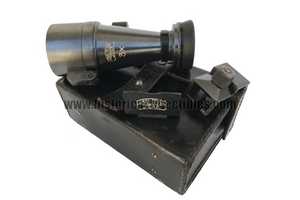Glasvisier Carl Zeiss 3x for Rifle Sharpshooters, about 1917
Prototype or experimental 3x optical sight produced by Carl Zeiss Jena in about 1917.
Given that the optics, reporting no production serial number, has greatly intrigued us, we therefore wanted to deepen the study by addressing it above all to the unusual accessories contained in its original leather top case.
Having carried out the necessary research without significant results, we also found that they do not allow mounting on any long-known series-produced weapon during World War I, so it is very likely that the weapon on which this optical sight was installed was also experimental.
The optical sight is apparently due to its design to the Fliegervisier Mod.16 but some significant details distinguish it technically as the 3x magnifications, the tilting of the optical tube from the objective lens group, the possibility to aim the target with a ratio of 1/1 or choose the enlargements and finally the special accessories for its installation on the weapon.
Aware that we are not currently aware of the existence of other specimens of optical sight with these specific characteristics, we therefore forwarded some requests to the staff of the Carl Zeiss museum, looking for information, documents, technical drawings or photos that might be present in their archive but they confirmed the total absence of this.
Therefore with logic reason we believe this optical sight to be a prototype or "experimental", perhaps the first and the only one realized of what should have become a small and innovative production of weapon with optics for Scharfschützen.
Given its excellent conditions of conservation and completeness, it seems to have never been used.
The only specimen currently known with these characteristics and so complete.
Carl Zeiss takes its name from its founder, Carl Zeiss, who on November 17, 1846 chose the small town of Jena, in Thuringia, as the location for his precision optical equipment factory. Thanks to the severe quality control that Carl Zeiss imposed on his products, going so far as to personally destroy the microscopes that did not pass the tests, the newly formed Zeiss became the official supplier of the University of Jena and received the gold medal of the industrial exhibition in 1861 of Thuringia as the best research instrument produced in Germany, awarded to the Stand I microscope of 1857.
In 1866 the thousandth microscope was produced and the name Zeiss became known throughout European scientific circles. Thanks to studies on the Porro prism, in 1893 Abbe patented double prism binoculars, which accentuated the perception of depth. The mass production of Zeiss binoculars began in 1894, already at the beginning of the twentieth century more than 30,000 were made, at the beginning of the First World War the quota had risen to 500,000 and, at the end of the Second World War, as many as 2,260,000 were produced binoculars for the civil and military market.
Models were made starting from 4x11 mm to 12x40 mm, up to real giants such as the 80 mm and 100 mm.
Thanks to studies conducted on the perception of light in low light situations, it was demonstrated that the average dilation of the pupil in an adult is approximately 7 mm.
For this reason, the 7x50 mm model was introduced in 1910 and remained on the market until 1917 with few changes to the materials used. In 1926, following the post-war crisis of the First World War with the Treaty of Versailles which bankrupted many important German companies, Zeiss purchased "C.P. GOERZ" and founded Zeiss Ikon in 1926.
In 1937 Zeiss had commercial contacts and factories in more than 29 countries around the world. From '33 Zeiss acquired interest from the Nazi regime, which balanced production towards military instruments. It successfully produced binoculars with wide-angle optics for military use, pressure-resistant optical systems for U-boats, periscope binoculars for targeting tanks. Furthermore, Zeiss cameras were mounted on the V2s for remote sensing operations of the English coasts.
On 1 November 1935, Zeiss, in the figure of Alexander Smakula, patented a process for the treatment of optical glass with extraordinary results in terms of light transmission. Remained a military secret until 1939, it was adopted on binoculars to reduce ghost images and internal reflections. During the Second World War, there were numerous bombings against the Zeiss factories. Jena was bombed several times by the Allies starting in 1944. Stuttgart was razed to the ground, although the Contessa-Nettel factory suffered little damage. The bombing of Dresden, in addition to devastating the city, also caused considerable damage to the Zeiss Ikon headquarters.
On April 13, 1945, American military forces entered Jena, surprising themselves that the bombing had not caused any significant damage. The main planetarium was in ruins, while the factories remained operational.

